


XCZU19EG
Model
Z19-PEan
6971390279762Price
$ 7925Satisfies network communication, high-speed data exchange storage, industrial control, in-depth learning, AI intelligence, cloud computing, 4K video transmission processing, and aerospace applications
Quad Core ARM Cortex™-A53 + Dual Core ARM Cortex™-R5
Mali™-400 MP2 GPU
PS 5GB DDR4、PL 4GB DDR4
32GB eMMC FLASH、128MB QSPI FLASH

Development Software Version. Vitis 2020.1 Linux Version. petalinux 5.4.0-xilinx-v2020.1 All Doucments Saved in Dropbox, after buy the board, email to get it.
Development Environment
01. Vitis Installation
02. Install virtual machine and Ubuntu system
03. Install Linux version of Vitis software on Ubuntu
04. Petalinux tool installation
05. NFS service software installation
06. QT Creator development environment
07. Linux Common Commands Remark. Vitis 2020.1
FPGA Experiment Tutorial
01. Introduction to Ultrascale+ MPSoC
02. PL's "Hello World" LED experiment
03. PL side DDR4 read and write test experiment
04. Experience ARM, bare metal output "Hello World"
05. PS RTC Interrupt Experiment
06. PS MIO Experiment
07. PS Side UART Read and Write Control
08. PS Side Use of I2C
09. PS Side Use of Display Port
10. PS Side SD Card Read and Write
11. PS Side Use of Ethernet LWIP
12. PS Side Remote Update QSPI Flash by Ethernet
13. Use of System Monitor
14. PS MIO Experiment
15. PL Side Use of AXI GPIO
16. Custom IP experimen
17. Use of “Free RTOS”under ZYNQ
18. PL Read and Write PS DDR Data
19. Realize PS and PL Data Interaction through BRAM S
20. DMA Loop Test
21. PCIe Test
Linux Basic Tutorial
01. Customizing Linux with Petalinux
02. Add Boot Scripts and User Files
03. Program hello world
04. NFS service
05. gpio Control LED
06. QT and OPENCV Cross-Compilation Environment
07. Use Vitis to Develop Linux Programs
08. Vitis Accelerates Basic Platform Creation
09. NVMe SSD operation under Linux
10. From QSPI Flashstart-up Linux
11. From EMMC Flashstart-up Linux
Remark: Linux Version petalinux 5.4.0-xilinx-v2020.1
Linux Driver Tutorial
01. Character Device
02. A New Way of Writing Character Devices
03. Device Tree and of Function
04. pinctrl and gpio Subsystem
05. Concurrent Processing
06. Timer
07. platform Platform equipment
08. Platform and Device Tree
09. MISC device driver
10. pwm Drive
11. I2C Drive
12. SPI Drive
13. Uart Driver
14. Block Device Driver
15. NIC driver
16. DMA Drive
Linux Application Development Tutorial
01. Building a Minimalist Working Environment
02. Hello World with Remote Debugging
03. OpenCV Edge Detection
04. OpenCV+Qt Face Detection
05. GStreamer's Camera Display
06. Qt+DRM+Gstreamer Camera Display
07. Qt+GPU Camera Display
08. Linux Register Operation
Vitis-AI Basic
01. Docker Environment Construction
02. Vitis-AI Development Process
03. Neural Network Training based on Keras Framework
04. Debugging Tools
*Click the picture above to view the details of the core board>>
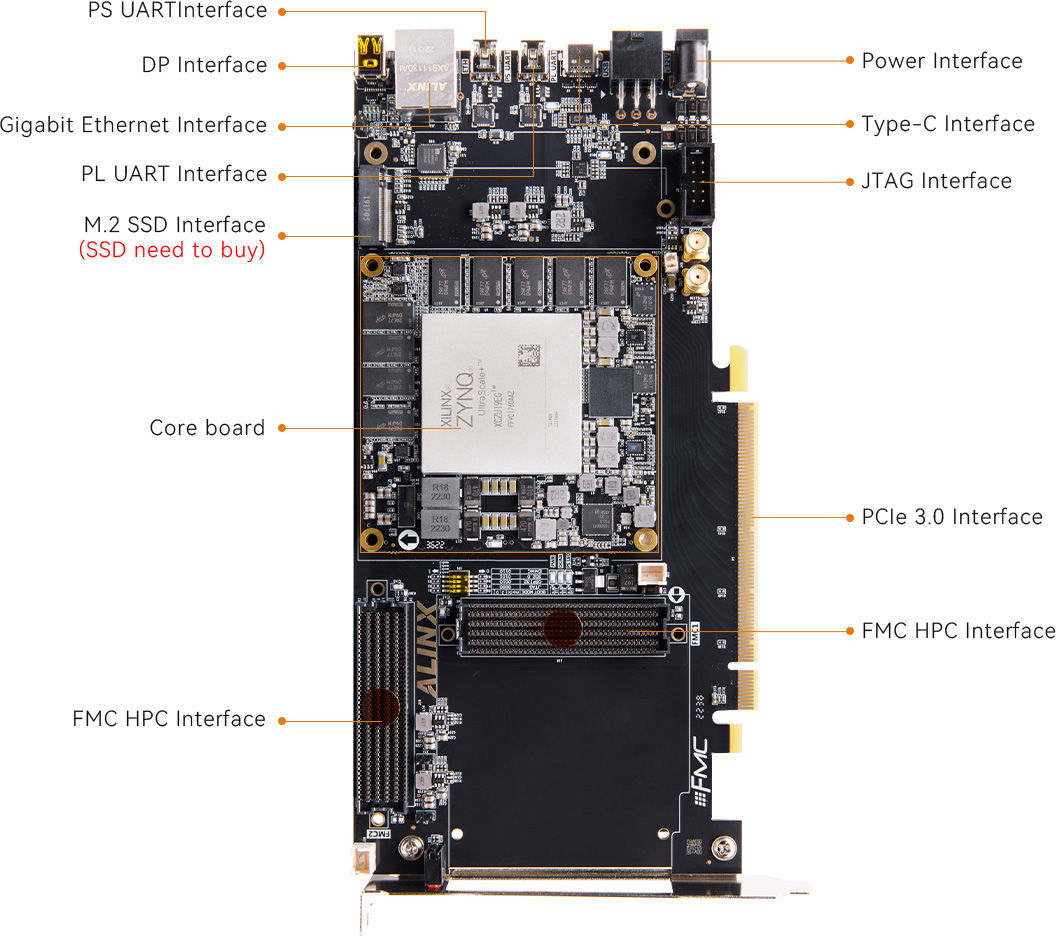
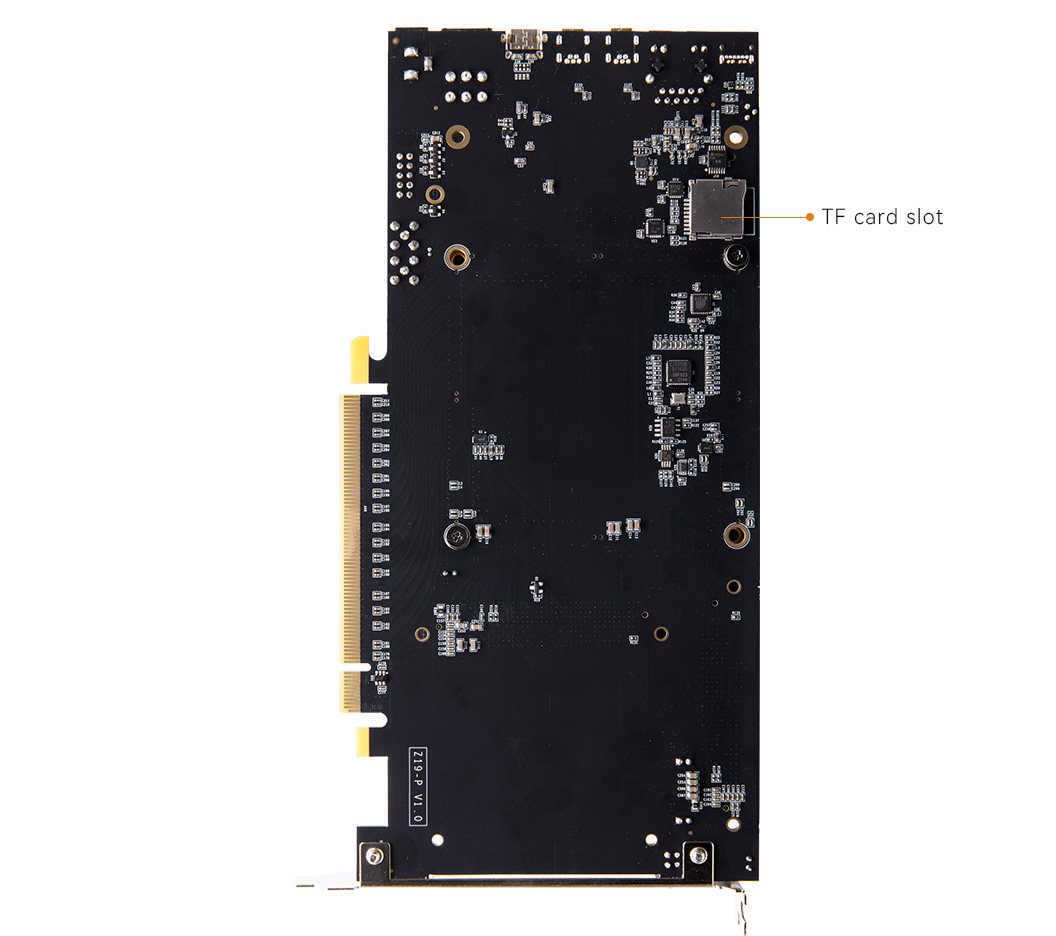
SoM Module
ACU19EG
FPGA Chip
XCZU19EG-2FFVC1760I
Chip CPU
ARM Cortex™-A53 x4, 1.333GHz,Dual core Cortex™-R5, 533MHz
GPU
Mali™-400 MP2
RAM
PS DDR4,5GB,72bit,2400Mbps, Support ECC
PL DDR4,4GB,64bit, 2400Mbps
PS side High-Speed Connection
PCIe Gen2 x4, 2x USB3.0, SATA 3.1, DisplayPort, 4x Tri-mode Gigabit Ethernet
PS side General Connection
2 x USB 2.0, 2 x SD/SDIO, 2 x UART, 2 x CAN 2.0B,2 x I2C, 2 x SPI, 4 x 32b GPIO
Chip Level
Speed Grades: -2; Industrial Grade, Working Temperature -40°c~85°c
Logic Cells
1,143K
Flip-Flops
1,045K
LUTs
523K
Distributed RAM
9.8Mb
Block RAM
34.6Mb
Ultra RAM
36.0Mb
CMTs
11
DSP Slices
1,968
150G Interlaken
4
100G Ethernet
4
PL PCIE Gen 3
PCIE Gen3 x 5
PL GTH
12.5Gb/s x 32
PL GTY
28.21Gb/s x 16
PL HP I/O
240
PL HD I/O
96
eMMC FLASH
32GB
QSPI FLASH
128MB
Expansion port
8-way 120-pin 0.5mm spacing extension connector with Panasonic high-speed industrial grade board-to-board connector
Crystal oscillator
1 RTC real-time clock provides 32.768 KHz real-time clock source for PS system
1 single-ended 33.333MHz crystal vibration is supplied to the PS system clock input
1 Differential 200MHz crystal oscillation supplied to PL logic, DDR4 reference clock
FMC Extension
2 standard FMC HPC extensions, external XILINX or ALINX various FMC subboards ( HDMI input and output module, binocular camera module, high speed AD module, etc. )
PCIE 3.0 Interface
1-way PCIE 3.0 X16 interface for PCIE data communication with PCs
DP Output Interface
1-way standard Display Port output display interface for video image display with maximum support 4K@30Hz perhaps 1080P@60Hz Output.
Type-C interface
1-way USB3.0 Type-C interface, supporting HOST, SLAVE, OTG three modes
M.2 Interface
1-way PCIEx1 standard M.2 interface for connecting M. 2 SSD solid state hard disk, communication speed up to 6Gbps (SSD fixed hard disk needs self-purchase)
USB Serial Port
2 Uart to USB interfaces, one for PS and one for PL to communicate with computer for user debugging
Gigabit Ethernet
1-way 10/100/1000M Ethernet with RJ-45 Interfaces for Data Exchange
Differential Clock
2-way 156.25M Differential Reference Clock Input
JTAG
10-pin 2.54mm standard JTAG port for downloading and debugging of field programmers
Temperature sensor
1 temperature sensor chip LM75A to detect ambient temperature
EEPROM
EEPROM 24LC04 with 1 piece of IIC interface
RTC Real Time Clock
1 built-in RTC real-time clock
TF card slot
1-way Micro SD card interface for storing operating system mirrors and file systems
LEDs
1 power indicator,2 user lights, 1 DONE configuration light
Voltage Input
+12 V DC
Current Input
Max. Current 3A
FPGA Board
1
DC Fan (Fixed on the Board)
1
Mini USB Cable
1
USB Downloader Cable
1 Set
12V Power Adapter
1
PCIe Fence
1
TF Card
1
Card Reader
1
Size Dimension
225.81mm x 106.65mm
Number of Layers
16-Layer Core Board PCB, 12-Layer Carrier Board PCB Reserve independent power layer and GND layer
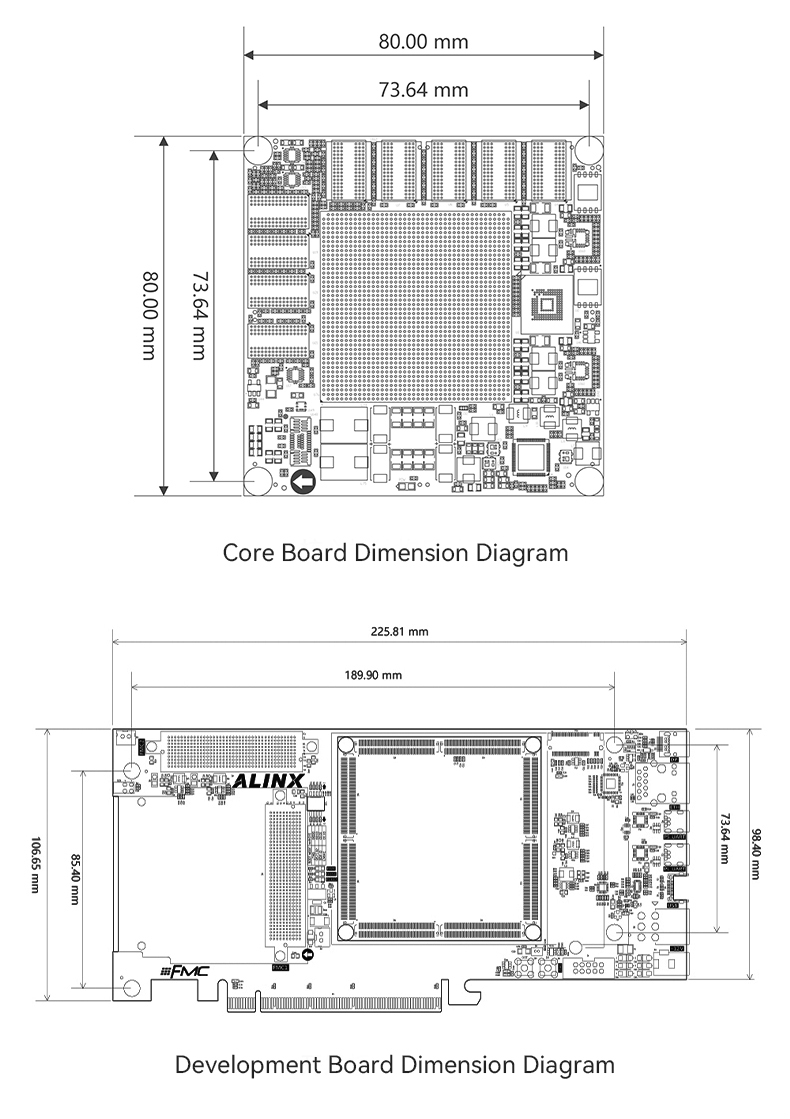
Automatic driving of 16 way on-board camera, vehicle simulation, SDI 4K video, high-speed camera acquisition with Camera Link interface
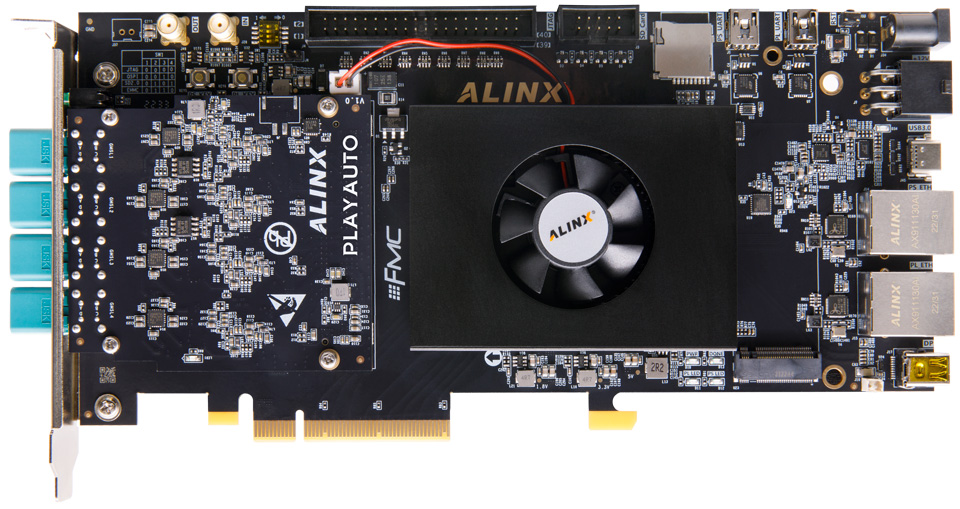

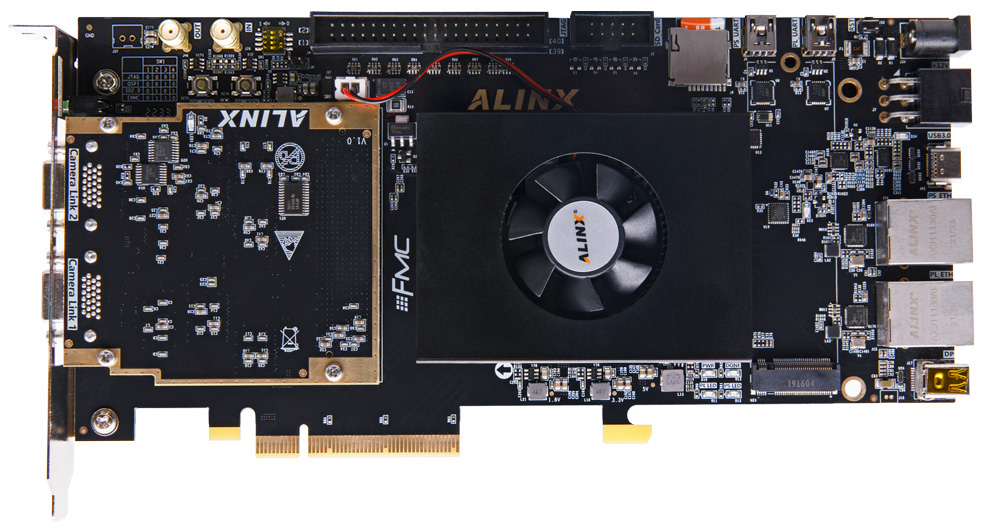
Intelligent identification and detection, image and video processing, security monitoring, machine vision, fire monitoring,
traffic safety, smart construction site, smart hotel, smart agriculture, Internet of Things

Vehicle Identification
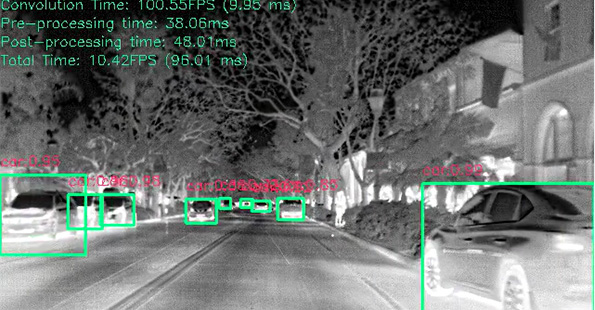
Infrared Vehicle Identification

Pedestrian recognition

Indoor Person Recognition

Fire detection

Helmet detection
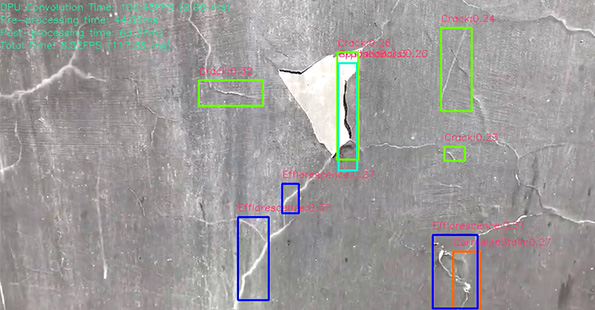
Concrete defect detection
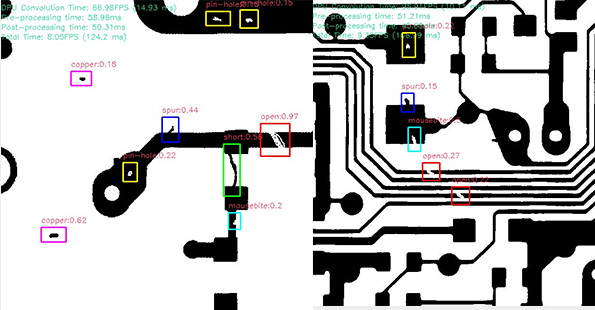
PCB defect detection
The warranty period of all products sold is 12 months, of which FPGA chips and LCD screens are wearing parts and are not covered by the warranty. All accessories and gifts are not covered under warranty.